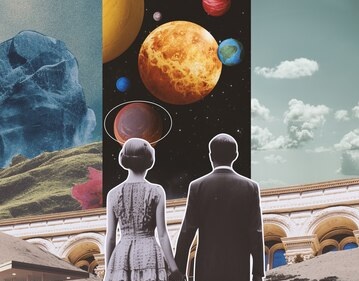In the ever-evolving landscape of contemporary art, the integration of technology has brought forth a wave of innovation and creativity.
However, amidst the advancements lie critical challenges that demand attention and discussion.
From disparities in access to technology hindering participation to ethical dilemmas surrounding privacy and authenticity, the intersection of technology and art raises complex questions. Issues such as the erosion of traditional craftsmanship and concerns about artistic intent amidst growing dependency on technology underscore the need for thoughtful consideration. As we navigate this dynamic nexus, it is essential to engage in dialogue and action to ensure that technology enriches rather than detracts from the integrity of contemporary art. Join Sama 6 TV News as we delve into these pressing issues and explore pathways towards a more inclusive, ethical, and sustainable artistic future.
Contemporary art stands at the intersection of creativity and innovation, constantly evolving to reflect the society it inhabits. In the 21st century, the rapid advancement of technology has emerged as a catalyst for profound changes in artistic expression.
From digital mediums to interactive installations, the integration of technology has revolutionized not only the way art is created but also how it is experienced and understood. This article explores the multifaceted impact of technology on contemporary art, examining its role in reshaping artistic practices, fostering new forms of engagement, and presenting both opportunities and challenges for artists and audiences alike.
Table of Contents
Technological Tools and Techniques in Contemporary Art
In the expansive landscape of contemporary art, technology serves as both a medium and a muse. Digital art has surged to the forefront, with artists utilizing digital painting, 3D modeling, and animation to push the boundaries of visual storytelling. Concurrently, interactive installations blur the lines between creator and observer, employing sensors and responsive environments to invite active participation. Moreover, internet-based art has redefined exhibition spaces, with platforms like social media becoming integral to artistic expression and dissemination.
Impact on Artistic Practices
The integration of technology has democratized the creative process, lowering barriers to entry and empowering a diverse array of voices. Artists now have unprecedented access to digital tools and global platforms, facilitating collaboration and experimentation across disciplines. Furthermore, technology has sparked new avenues of exploration, prompting artists to reflect on the complexities of the digital age and its societal implications.
Collaborative endeavors between artists and technologists have led to groundbreaking innovations, pushing the boundaries of traditional art forms and forging new frontiers of creativity.
Changing Audience Engagement and Experience
Technology has revolutionized the way audiences engage with and experience art, ushering in a new era of immersive and interactive experiences. Virtual reality exhibitions transport viewers into alternate realities, while interactive installations foster dialogue and interaction.
Online platforms have democratized access to art, reaching global audiences and fostering inclusivity. However, alongside these opportunities, technology also presents challenges, including issues of access, dependency, and ethical considerations.
Challenges and Critiques
Despite its transformative potential, the integration of technology into contemporary art is not without its challenges.
The digital divide and issues of access persist, perpetuating inequalities within the art world. Concerns about the loss of traditional craftsmanship and the ethical implications of technology raise questions about authenticity and preservation. Furthermore, as technology continues to evolve, artists grapple with the balance between innovation and artistic integrity, navigating the complexities of a rapidly changing landscape.
The influence of technology on contemporary arts is profound, bringing both challenges and critiques to the forefront. Here are some key points:
- Accessibility vs. Exclusivity: Technology has made art more accessible to a wider audience through platforms like social media, online galleries, and digital exhibitions. However, it has also raised concerns about exclusivity, as those who lack access to technology or digital literacy may be left out.
- Digitalization of Art: The advent of digital tools has led to the creation of digital art forms such as digital painting, computer-generated imagery (CGI), and interactive art installations. While these forms offer new avenues for creativity, they also challenge traditional notions of materiality and authenticity in art.
- Copyright and Ownership: The ease of replicating and sharing digital artworks online has raised questions about copyright infringement and intellectual property rights. Artists must navigate complex legal and ethical issues surrounding the ownership and distribution of their digital creations.
- Algorithmic Bias: Technology-driven art forms often rely on algorithms and machine learning techniques, which can perpetuate biases present in the data used to train them. This raises concerns about the reinforcement of existing inequalities and stereotypes in contemporary art practices.
- Loss of Craftsmanship: Some critics argue that the rise of digital tools has led to a decline in traditional craftsmanship and artistic skills. As artists increasingly rely on software and automation, there is a risk of losing the tactile and manual aspects of art-making.
- Environmental Impact: The production and consumption of digital art have environmental consequences, including energy consumption from data storage and processing, as well as electronic waste from obsolete hardware. Artists and institutions are increasingly conscious of their environmental footprint and seeking sustainable solutions.
- Surveillance and Privacy: Technology-enabled art installations and interactive experiences often collect data from viewers, raising concerns about surveillance and privacy. Artists must navigate ethical considerations regarding the collection and use of personal information in their work.
- Cultural Homogenization: The globalization of digital platforms can lead to cultural homogenization, as dominant narratives and aesthetic trends become more prevalent worldwide. This can marginalize local and indigenous artistic practices, leading to concerns about cultural diversity and representation in contemporary art.
In conclusion, while technology offers exciting opportunities for innovation and creativity in contemporary arts, it also presents significant challenges and critiques that artists, critics, and audiences must address. Balancing accessibility with exclusivity, navigating copyright and ownership issues, addressing algorithmic bias, and considering the environmental and ethical implications of digital art are essential aspects of the ongoing dialogue surrounding technology’s influence on the arts.

